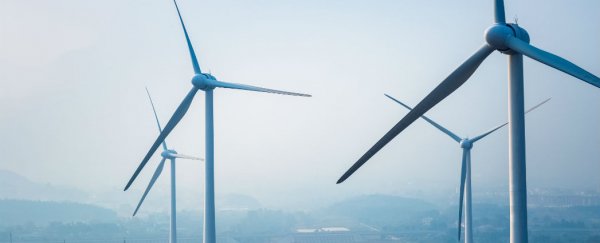China loves nuclear power. It's currently building more nuclear reactors than any other country on Earth, with plans to triple its nuclear power production by 2020. But at the same time, it's getting 100 percent behind the potential of wind power, expanding its capacity to harvest it at an even speedier rate than nuclear.
Just last year, the total amount of energy harvested from China's wind farms went up an impressive 16 percent from the previous year, and was enough to power 110 million homes. That's pretty incredible. Compared directly to their nuclear power output, the 115 gigawatts of wind power produced by China in 2014 dwarfed the 20,000 megawatts (a gigawatt is 1,000 megawatts) from its nuclear sector, as Richard Macauley points out at Quartz, and is more than the total output of power from all of the nuclear plants in the US.
And it's not just about the environment, says Macauley. China's identified wind power as the most practical form of energy for them, as they struggle to produce enough water for their nuclear plants, and after the 2011 Fukushima disaster in Japan, they're not putting any of those plants on earthquake-prone land. It makes so much sense for China that the Earth Policy Institute reports that its wind power goal is to have 200 gigawatts connected to the grid by 2020.
J. Matthew Roney at the Earth Policy Institute describes the situation:
"China is building the world's largest ultra-high-voltage transmission system, which is connecting remote, wind-rich northern and western provinces to the more populous central and eastern ones. At the same time, the government is providing incentives for wind farm development in less-windy areas nearer to population centres. Advances in wind power technology can allow greater capture of energy in spots without the strongest wind resources."
Not to be outdone though, the US Department of Energy has announced, via its newly published Wind Vision report, that it's economically viable for the the amount of energy produced by its wind farms to more than double over the next five years, increasing from providing 4.5 percent of the national energy requirements to 10 percent by 2020. They predict this will increase to 20 percent by 2030, and to 35 percent by 2050. This means, says Brian Merchant at Motherboard, the US could be running on over one-third wind power in less than 40 years.
Researchers have shown that there is enough wind to meet the entire world's energy needs seven times over with the next 20 years. It's pretty exciting that two of the world's most powerful nations are starting to pay attention.
Sources: Quartz, Motherboard, The Earth Policy Institute
